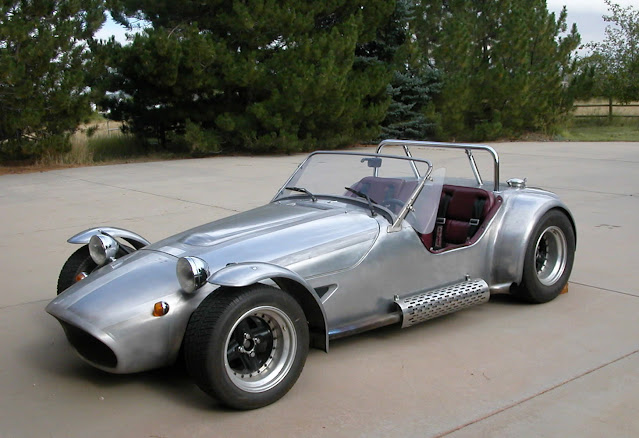The Maxton Mille Miglia
As covered previously, one of my personal favorite component cars was introduced to the world in 1991. Created by Bob Sutherland, the visionary and financier, Dan Ripley CEO, and designer Michael Mate under the brand of Maxton Components, it was called the Rollerskate.
Basically a modern interpretation of the classic British roadster, it blended elements from the old "bugeye" sprites, Triumphs, and the spartan feel of the Lotus 7. All of that with a modern twist and a reliable Japanese donor car.
 |
| The Rollerskate and Mille Miglia prototypes |
While the production version is more well known, it was almost a very different car. Michael Mate had a number of alternate ideas on the aforementioned formula or theme. As the initial mule and prototypes were being produced, the company envisioned a 2 model range. Early advertising materials touted them as the "Rollerskate" and the "Mille Miglia", which was named in honor of the legendary racing event.
Like the early test mule, constructed to prove out the Maxton concept, the Mille Miglia was designed to use a Nissan L28 inline 6 cylinder engine from the 280z and components sourced from the Alfa Romeo Alfetta, including its transmission and rear suspension. The idea was "a smaller and less expensive Maxton", as early advertising suggested. This would prove ironic later.
 |
| The Mille Miglia prototype's supercharged L28 |
Like the Rollerskate, the Mille Miglia had a tubular spaceframe chassis. This was designed and built by Church Green Engineering in the UK and featured a De Dion-type rear suspension at the rear, with a rocker-arm setup at the front and disc brakes at all 4 corners. The Rollerskate had a more sophisticated chassis spec.
Another UK firm of note was also involved in the project, Cosworth. They lent their talents to modifying the L28 motor, which had a supercharger courtesy of B&M as well. This was good for 220bhp and plenty of fun at speed in such a light package.
 |
| The Mille Miglia |
Though ultimately intended to be made of fiberglass, the Mille Miglia prototype body was made of hand formed aluminum at Church Green in the UK. It remained unpainted, with a polished metal sheen. A gutsy looking side-pipe with a heat shroud sprouted out from behind the driver's side fender. Overall it looked like a more shapely and muscular take on a Lotus 7 theme.
The Mille Miglia's interior boasted a full compliment of gauges on its black dashboard and red leather upholstery around the seats and center console. The stick-shift was off-center from the middle of the interior, toward the driver. A small glovebox on the passenger side was a small nod to practicality. A roll-bar was tucked neatly into the bodywork, but no provisions for a top were made.
 |
| The Mille Miglia interior |
Despite being developed concurrently with the Rollerskate, as a cheaper "sibling", it turned out that the Mille Miglia was actually more expensive to produce. It was determined that, even with a fiberglass body, the car wasn't feasible for series manufacture. So, Mr. Sunderland kept the car for his own enjoyment and pressed on with the Rollerskate.
Unfortunately, in their short 3 year run just 50 production Rollerskates were built. The venture fell victim to the economic downturn of the mid 90's. However, there is a very active community among owners of the car and many of the company's original team are involved in supporting Rollerskate owners.
The Mille Miglia is now owned by Rick Landeira, who said of the car and its designer, "Fun and fast but too expensive to produce in aluminum... Just my biased opinion, but it's much better looking than its Lotus inspiration. Michael Mate was a great styling artist. I miss him very much".
Sources:
Maxton
Rick Landeira
Maxton
Rick Landeira











A very good looking car for a 'sevenesque' design. And with straight 6 and de Dion rear etc. Tremendous
ReplyDeleteDave Roberts